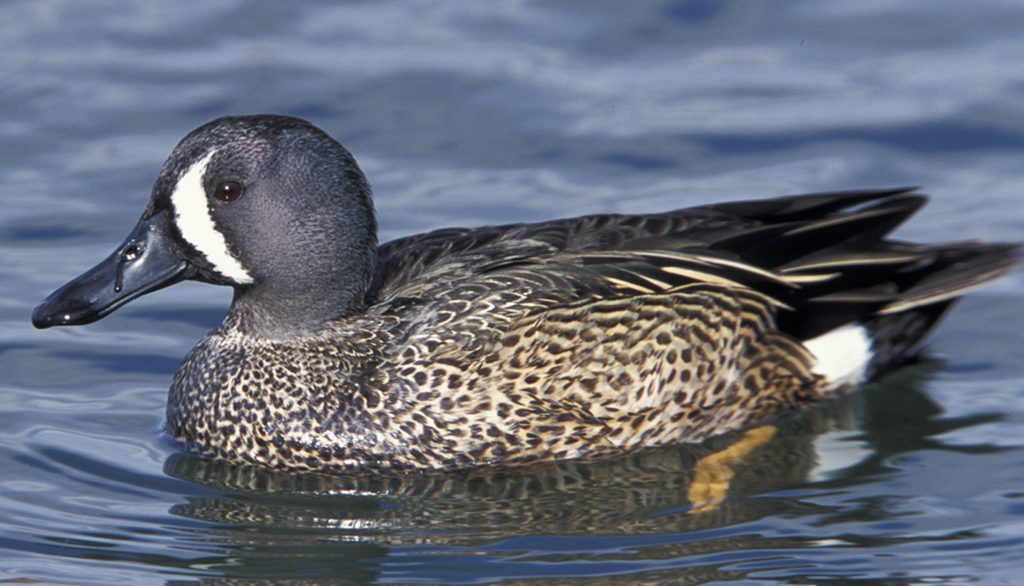
The Teal ducks are the smallest of the dabblers.
There are three different kinds of Teal dabbling ducks and one is not much bigger or smaller than the other.
There is the Cinnamon Teal and the Green-winged Teal.
Due to their size, they do tend to stick to groups and can be found in shallow ponds and wetlands.
Other Names: Sarcelle a ailes bleues (French) and Cerceta Aliazul (Spanish)
Found in these parts of the US: They can be found throughout North America and South America during the North American winter months.
Migratory? They tend to leave early in Spring and Fall for these migrations. This is a lot earlier than most other breeds.
They are long-distance migrants that travel all the way to South America for the winter
.
Favorite Habitat: In North America, they will generally be found in marshes, shallow ponds, wetlands that have a lot of vegetation, lakes and rice fields.
They much prefer fresh water to salt water and in their North American winter months opt for vegetated wetlands with decaying organic matter.
Other Know Habitats: When they head south, they look for mangroves and estuaries.
Mating Habits They use weird exaggerating gestures when courting. For instance, the male has been known to bob his head up and down, tip it into the water and even dabbling with his body feathers raised in the water.
The female will respond in kind by lowering her head, pointing her beak at the male before once again raising her head.
They pair during the winter or spring and stair paired until incubation.
The pair bond will then be dissolved, and new pair bonds will be formed the following breeding season.
The same male does tend to court the same female the following year, but it is up to her to decide on her mate.
Nesting Habitat: Nests are built at least a foot above the nearest water.
Nest Details: The male will wait nearby the place the female is inspecting as a possible position for her nest.
Her nest is built from grass she has found around the area where she has decided to nest. This she adds her breast feather to whilst vegetation will conceal the sides of the nest as well as from above.
Nesting Information:
Clutch Size
6 – 14 eggs
No. Broods
1
Incubation Time Egg Color
19 – 29 days Creamy white
Hatchlings: They are not the best of mothers as their young are basically left to fend for themselves. They will all leave the nest within 24 hours of hatching.
She will keep an eye on them for the first 1 – 2 weeks.
Ducklings: Ducklings of this breed are generally left on their own by their mother before they can even fly.
Once they can fly, they will join the rest of the flock to migrate.
They are able to fly at around 38 days after birth.
Characteristics: One of the oldest recorded Blue-winged Teals was 23 years and 3 months old.
They are known to be warm weather ducks as they will migrate south a lot earlier than other duck breeds.
They will migrate as far as South America looking for warmer days.
Favorite Foods: Their favorite foods are aquatic insects such as the midge larvae, clams, snails and crustaceans.
But they also enjoy grains and vegetation as much as the other breeds do.
 Gadwall – Wild Dabbling Duck Breed
Gadwall – Wild Dabbling Duck Breed American Wigeon – Wild Dabbling Duck Breed
American Wigeon – Wild Dabbling Duck Breed Aylesbury Duck Breed – Everything You Need to Know
Aylesbury Duck Breed – Everything You Need to Know Duclair Duck Breed – Everything You Need to Know
Duclair Duck Breed – Everything You Need to Know Australian Spotted Duck Breed – Everything You Need to Know
Australian Spotted Duck Breed – Everything You Need to Know The Types and Breeds of Ducks – Getting your Ducks in a Row – Part 1
The Types and Breeds of Ducks – Getting your Ducks in a Row – Part 1 Appleyard Duck Breed – Everything You Need to Know
Appleyard Duck Breed – Everything You Need to Know Orpington Duck Breed – Everything You Need to Know
Orpington Duck Breed – Everything You Need to Know The Best Wild Ducks for Meat Production
The Best Wild Ducks for Meat Production Muscovy Duck Breed – Everything You Need to Know
Muscovy Duck Breed – Everything You Need to Know The Best Domestic Duck Breeds for Meat Production
The Best Domestic Duck Breeds for Meat Production Ancona Duck Breed – Everything You Need to Know
Ancona Duck Breed – Everything You Need to Know